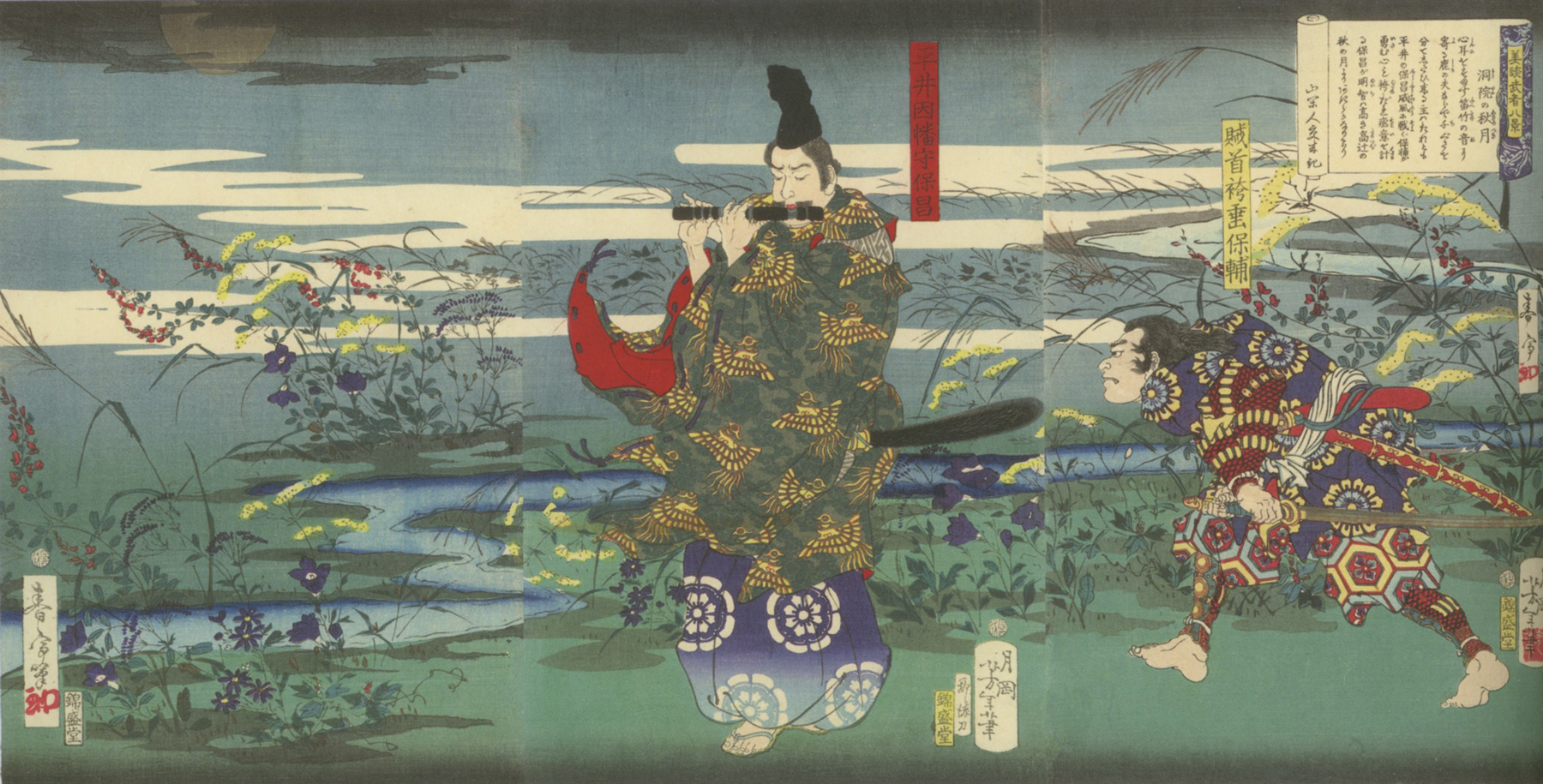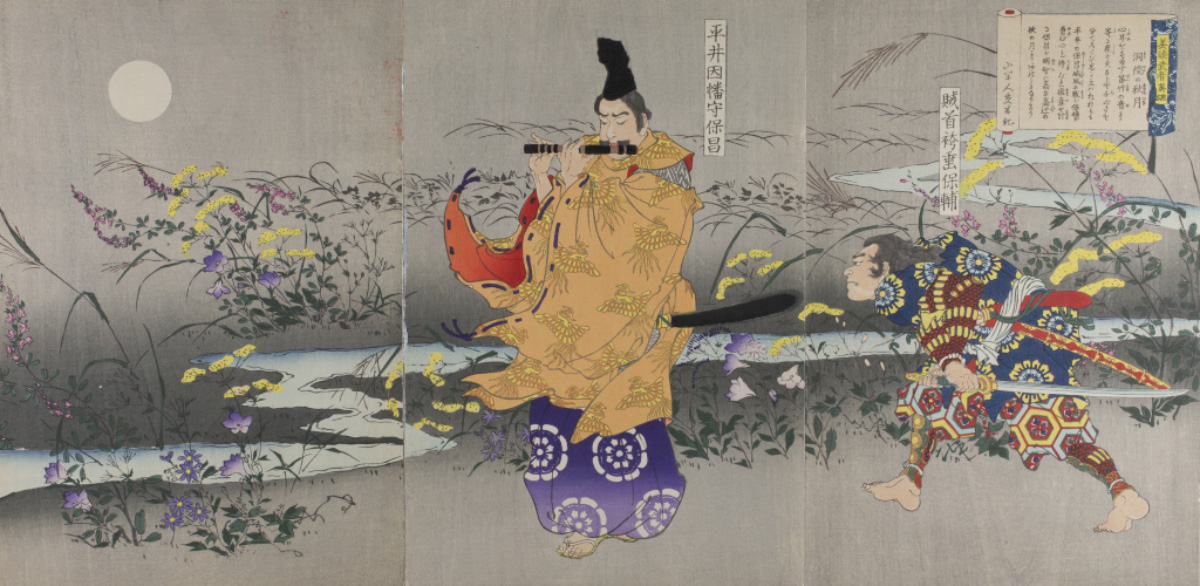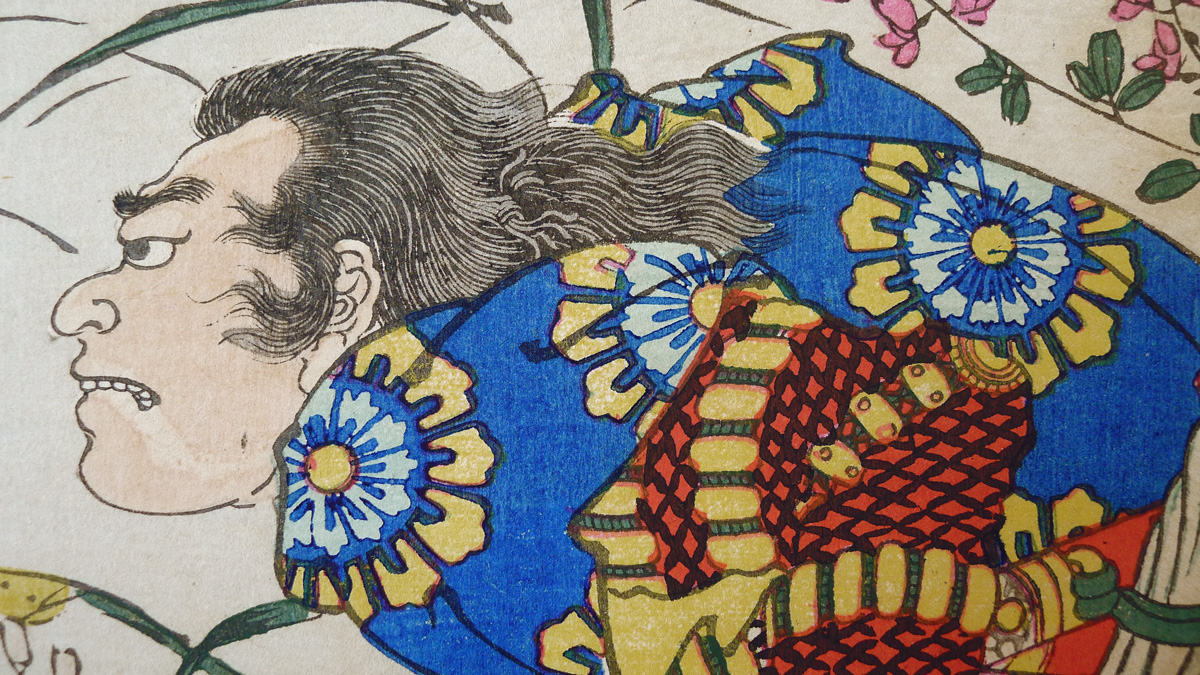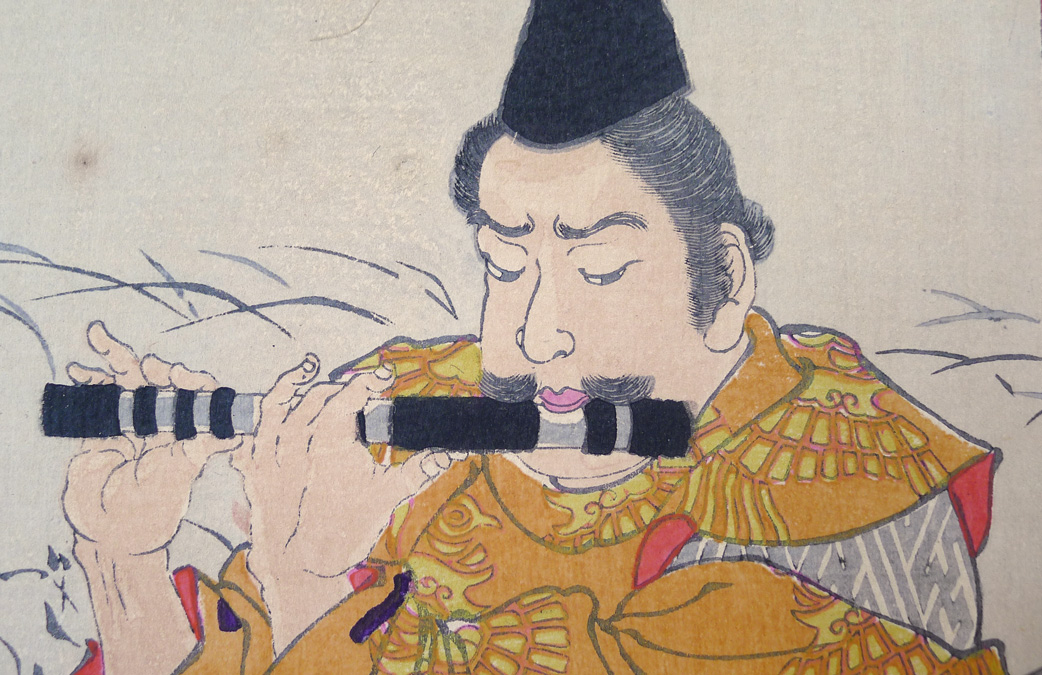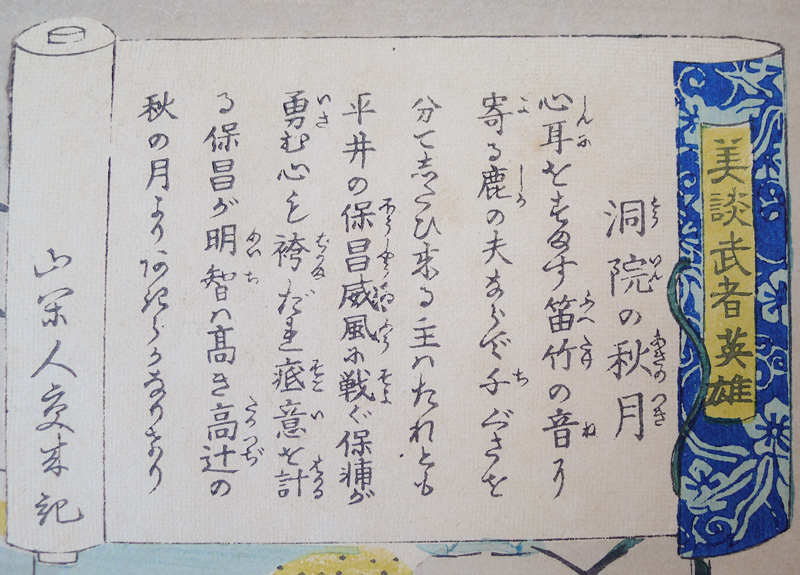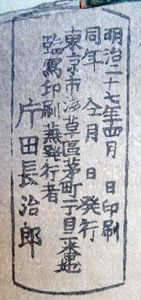About This Print
Source: Yoshitoshi, Masterpieces from the Ed Freis Collection, Chris Uhlenbeck and Amy Reigle Newland, Hotei Publishing, 2011, p. 88, 112.
This print pictures Fujiwara no Yasumasa1, an aristocrat of distinction, playing his flute, being stalked by the outlaw Hakamadare Yasusuke2 who wants to steal Yasumasa's clothing. (See "The Story of Yasumasa's and Yasusuke's Encounter" below for one version of this tale.)
Originally issued in April 1868 (see image below), this print was reissued (a "second state") using a different color scheme and partially new blocks in April 1884. This reissue also used at least two different color schemes for Yasumasa's outer robe, orange as in this collection's print and light blue as pictured in the image reprinted in Yoshitoshi, Masterpieces from the Ed Freis Collection, shown below. The Portland Art Museum holds a variant of the second state print bound into an accordion-fold album of ten triptychs titled Bijutsu Nihon rekishi zue, zen (Japanese History Illustrated in Art, complete), also shown below.
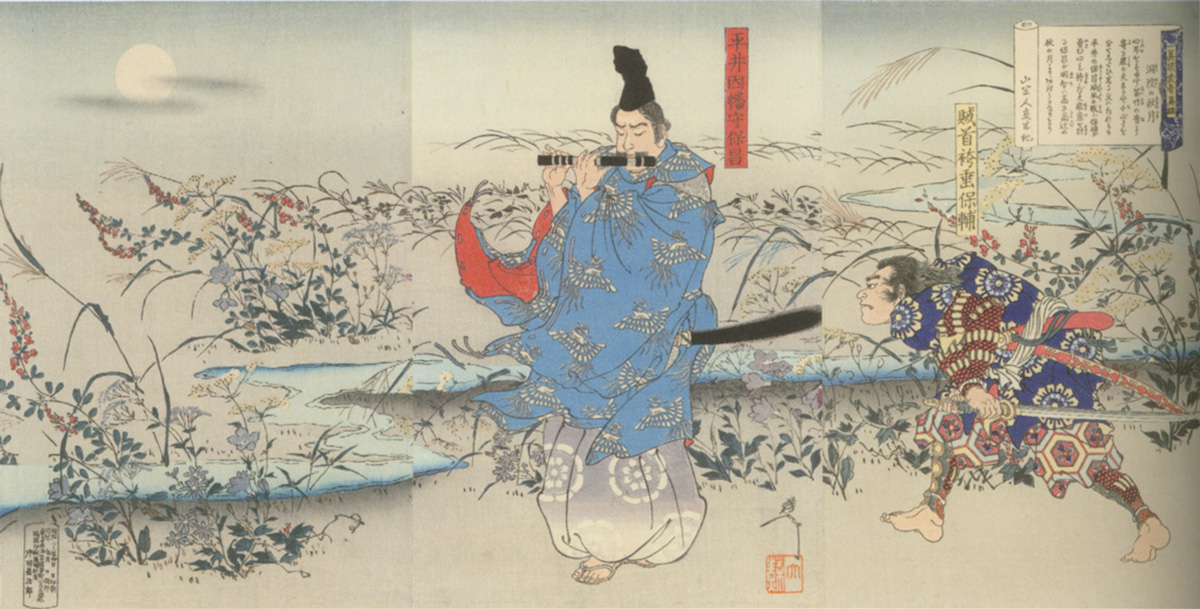 Autumn Moon (Tōin no aki no tsuki 洞院の秋月) Second State (with blue outer robe) Issued April 1884 (scanned from Yoshitoshi, Masterpieces from the Ed Freis Collection, cat. 51a, p. 88.) |
Commenting on this second state of the print, the editors of Yoshitoshi, Masterpieces from the Ed Freis Collection state, "It is quite possible that this re-issue was triggered by the success of Yoshitoshi’s later Flute player triptych of Yasumasa and Hakamadare from 1883." (Image follows.)
February 12, 1883
(scanned from Yoshitoshi, Masterpieces from the Ed Freis Collection, cat. 81, p. 112.)
1 平井 因幡守 保昌 Hirai Inabanokami Yasumasa as written in red cartouche
2 袴垂 賊首 保輔 Hakamadare Zokushi Yasusuke as written in yellow cartouche
The Story of Yasumasa's and Yasusuke's Encounter
Source: Legends of the Samurai, Hiroaki Sato, The Overlook Press, 1995| The belief that a great man can affect other people without using a word or making a gesture is conveyed well in an episode from Konjaku Monogatari Shu (vol. 25, sec. 7), where a nobleman overpowers a famous robber with sheer force of mind. About the robber Hakamadare (“Drooping Trouser-Skirt”) little that is certain is known. Fujiwara no Yasumasa (958-1036), on the other hand, appears in official records as an aristocrat of distinction who held a round of governorships. For a while he was married to the great poet and lover of many men, Lady Izumi (b. ca. 976), whose amorous liaisons were considered scandalous even in an age when sexual standards were far more tolerant. There was once a man who may be called the “generalissimo” of robbers and who went by the name of Hakamadare. He had a strong mind and a powerful build. He was swift of foot, quick with his hands, wise in thinking and plotting. Altogether there was no one who could compare with him. His business was to rob people of their possessions when they were off guard. Once, around the tenth month of a year, he needed clothing and decided to get hold of some. He went to prospective spots and walked about, looking. About midnight when people had gone to sleep and were quiet, under a somewhat blurry moon he saw a man dressed in abundant clothes sauntering about... The man, with his trouser-skirt tucked up with strings perhaps and in a formal hunting robe which gently covered his body, was playing the flute, alone, apparently in no hurry to go to any particular place. Wow, here’s a fellow who’s shown up just to give me his clothes, Hakamadare thought. Normally he would have gleefully run up and beaten his quarry down and robbed him of his clothes. But this time, unaccountably, he felt something fearsome about the man, so he followed him for a couple of hundred yards. The man himself didn’t seem to think, Somebody’s following me. On the contrary, he continued to play the flute with what appeared to be greater calm. Give him a try, Hakamadare said to himself, and ran up close to the man, making as much clatter as he could with his feet. The man, however, looked not the least disturbed. He simply turned to look, still paying the flute. It wasn’t possible to jump on him. Hakamadare ran off. Hakamadare tried similar approaches a number of times, but the man remained utterly unperturbed. Hakamadare recognized that he was dealing with an unusual fellow. When they had covered about a thousand yards, though, Hakamadare decided he couldn’t continue like this, drew his sword, and ran up to him. This time the man stopped playing the flute and, turning, said, “What in the world are you doing?” Hadamadare couldn’t have been struck with greater fear even if a demon or a god had run up to attack him when he was walking alone. For some unaccountable reason he lost both heart and courage. Overcome with deathly fear and despite himself, he fell on his knees and hands. “What are you doing?” the man repeated. Hakamadare felt he couldn’t escape even if he tried. “I’m trying to rob you,” he blurted out. “My name is Hakamadare.” I’ve heard there’s a man about with that name, yes. A dangerous, unusual fellow, I’m told,” the man said. Then he simply said to Hakamadare, “Come with me,” and continued on his way, playing the flute again. Terrified that he was dealing with no ordinary human being, and as if possessed by a demon or a god, Hakamadare followed the man, completely mystified. Eventually the man walked into a gate behind which was a large house. He stepped inside from the verandah after removing his shoes. While Hakamadare was thinking, He must be the master of this house, the man came back and summoned him. As he gave him a robe made of thick cotton cloth, he said, “If you need something like this in the future, just come and tell me. If you jump on somebody who doesn’t know your intentions, you may get hurt.” Afterward it occurred to Hakamadare that the house belonged to Governor of Settsu Fujiwara no Yasumasa. Later, when he was arrested, he is known to have observed, “He was such an unusually weird, terrifying man!” |
Scroll Detail
Print Details
| IHL Catalog | #699 |
| Title | Autumn Moon at Tōin (Tōin no aki no tsuki 洞院の秋月) |
| Series | Tales of Great Warriors (Bidan mushya eiyū 美談武者英雄) Series title for this print is sometimes given as Eight Views from the Tales of Warriors (Bidan Musha Hakkei 美談武者八景雄) |
| Artist | Tsukioka Yoshitoshi (1839-1892) |
| Signature | Yoshitoshi |
| Seal |  |
| Date | April 1884 |
| Publisher | Katada Chōjirō - 片田 長治郎 [Marks ref. 217, seal not shown] |
| Carver | not given |
| Impression | excellent |
| Colors | excellent |
| Condition | fair - trimmed to image, not backed, minor wrinkling; light staining right and middle panels with 1" wide stain running entire length on right edge of left panel |
| Genre | ukiyo-e |
| Miscellaneous | 2nd state of print which was originally issued in April 1868 (see "About This Print" for more details.) |
| Format | horizontal oban triptych |
| H x W Paper | 14 x 9 3/4 in. (35.6 x 23.4 cm) each sheet |
| Collections This Print | Portland Art Museum 2009.55 (included in an accordion-fold album of ten triptychs titled Bijutsu Nihon rekishi zue, zen (Japanese History Illustrated in Art) |
| Reference Literature | Yoshitoshi, Masterpieces from the Ed Freis Collection, Chris Uhlenbeck and Amy Reigle Newland, Hotei Publishing, 2011, p. 88, cat. 51a; The Male Journey in Japanese Prints, Roger Keyes, The Fine Arts Museum of San Francisco and The University of California Press, 1989, p. 119, Fig. 170. |



